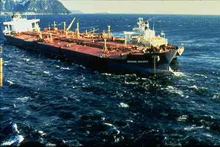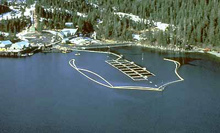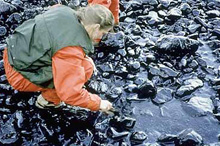Exxon Valdez Oil Spill
- Magnitude and Extent
- Responding to the Spill
- Enhancing NOAA’s Spill Response
- Larger Role in Spill Response
- Irony of it All
Magnitude and Extent of the Spill

The Exxon Valdez, three days after the vessel ran aground on Bligh Reef. The tragedy of this accident catapulted NOAA's capacity to conduct damage assessments for oil spill disasters by stimulating Congress to pass the Oil Pollution Control Act of 1990. Click image for larger view.
On March 24, 1989, the super tanker Exxon Valdez grounded on Bligh Reef in Alaska’s Prince William Sound. It spilled nearly 11 million gallons of crude oil into a very remote, scenic, and biologically diverse and productive area. It remains the largest oil spill to ever occur in U.S. waters. Extensive media coverage conveyed images of heavily oiled shorelines, dead and dying wildlife, and thousands of workers cleaning beaches. The oil spread over a wide area, ultimately affecting over 1,100 miles of Alaskan coastline.
Responding to the Spill

A protective boom around a salmon hatchery in Prince William Sound helped guard it from spilled oil moving across the sound. Click image for larger view.
In responding to the Exxon Valdez oil spill, NOAA mobilized unprecedented resources. Scientific and support staff collaborated with state and federal agencies to assess ecological impacts, to provide scientific advice on cleanup, and to help assure traditional subsistence gatherers of seafood safety. Response personnel from the Office of Response and Restoration served extended rotations in Alaska supporting the U.S. Coast Guard and other federal and state response agencies during cleanup operations lasting three years. Scientists from across NOAA conducted a natural resource damage assessment to quantify ecological impacts and lost economic values. These efforts formed the basis for a $900 million financial settlement with Exxon in 1991 for natural resource damages. This settlement is, by far, the largest single amount ever paid for natural resource damages arising from an oil spill or spills of any other hazardous substance in the U.S.
Prior to Exxon Valdez, the largest oil spill to which NOAA had ever responded was just under one million gallons. The Exxon Valdez spill tested the concept underlying NOAA's Office of Response and Restoration's Hazardous Materials Response Team (HAZMAT)–that a highly trained, multi-disciplinary cadre of scientists would be well-suited to provide “world-class” support for spill responders during major incidents. In the case of the Exxon Valdez, the volume of oil spilled, the geographic scope and severity of the impacts, and the diversity of scientific and logistical issues encountered resembled the challenges posed by several concurrent spills, rather than a single incident. The test revealed that the HAZMAT idea worked, but that NOAA needed significantly more spill response resources.
Enhancing NOAA’s Spill Response Capabilities

Pooled oil from the Exxon Valdez sits between rocks on the shore. Most of the spilled oil decomposed. Cleanup crews recovered about 14 percent; 13 percent sank to the sea floor; about two percent remained on the beaches, but today, very little remains. Click image for larger view.
The spill strengthened and enhanced NOAA’s capacity to respond to and help reduce impacts from hazardous material spills by stimulating passage of the Oil Pollution Control Act of 1990. The bill had been debated intermittently throughout the 1970s and 1980s, but it took the Exxon Valdez calamity to finally spur passage. This law authorized NOAA and others to assess and recover damages that oil spills heap on our environment. And it required that compensation collected from those responsible for spills be used to “make the public whole” by restoring coastal lands and waters to viable and productive natural conditions. As a result of the impetus for oil spill legislation brought on by the Exxon Valdez spill, NOAA is now considered a worldwide innovator and leader in providing technical advise for cleaning up oil and other hazardous material spills, for conducting natural resource damage assessments, and for restoring injured marine resources.
A Larger Role in Spill Response

A NOAA scientist surveying an oiled beach to assess the depth of oil penetration soon after the spill. Click image for larger view.
Prior to passage of the Oil Pollution Act, NOAA did not have the legal authority to conduct natural resource damage assessments resulting from oil spills or the ability to restore affected resources. In fact, until the Exxon Valdez spill, NOAA had carried out only one natural resource damage assessment. But NOAA conducted that assessment based on damages from hazardous materials other than oil and performed the assessment under the Comprehensive Environmental Response, Compensation, and Liability Act also know as “Superfund.”
Now, with the authority provided by the Oil Pollution Act, NOAA, at last, was able to conduct natural resource damage assessments for oil spills on a regular basis. So, in 1991, NOAA created a damage assessment and restoration program. This new program brought to the table expertise from across NOAA including economists, biologists, attorneys, and restoration specialists. And with it came the ability to determine levels of environmental damage, to collect compensation from those responsible for spills, and to restore damaged environments and injured resources.
The Irony of it All
Since the damage and restoration program was created, NOAA has collected (as of 2006) over $300 million for restoring natural resources injured by releases of oil and hazardous materials in coastal areas, as well as human-caused physical impacts to resources of national marine sanctuaries. There is a certain level of irony knowing that the largest and most damaging oil spill in U.S. history now enables the nation to make amends for environmental damage wrought by mishandling oil and other hazardous materials–whether through unavoidable accidents or careless blunders. The tragedy of Exxon Valdez oil spill of 1989 set in motion a course of events that has made NOAA the world leader in responding to oil spills in the marine environment.










